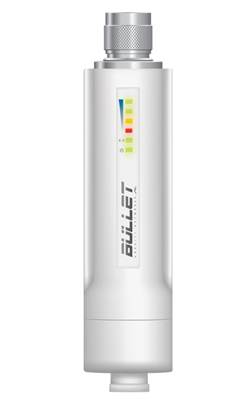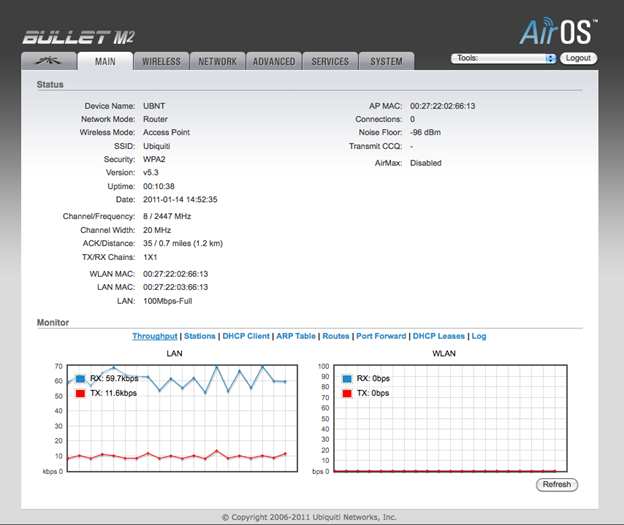Wireless networks are fast becoming a major player in the communications market. The benefits of lack of cabling are driving the costs associated with the wireless networks low enough to make them practically feasible. However, to ensure proper deployment, there needs to be a means of reliably tapping into the network to gain access to the bandwidth. This is where products like Ubiquiti bullet become so prominent. This small device weighing about 180 grams is built to be attached to the antenna to boost it’s transmit range and receiver sensitivity.
Wireless Specifications: These are part of Ubiquiti’s Zero Variable wireless deployments. This device is designed primarily to operate in the 2.4 GHz range and can support wireless b and g standards. In the 802.11b mode, it can support a maximum speed of 11 Mbps while in the 802.11g mode it bumps this speed up to 54 Mbps. The best part about these data rates is that they can be sustained over large distances. This device can cover a range of nearly 50 kms which is pretty good for any outdoor wireless deployment. However, the actual coverage would depend on many factors like the layout of the geography and the type of antenna used. High gain, directional antennas can cover much longer distances than standard omnidirectional ones.
The device also supports passive Power over Ethernet. This is typically very important in outdoor networks because having to run the Ethernet and the power cable to the access point can be very expensive; especially if the plan is to deploy the network on a large scale. With the help of PoE, the access point can draw power from the Ethernet cable itself making it simple and easy to deploy it.
Physical Design Considerations: The Ubiquiti bullet is quite different from the standard access point in that it does not have an elaborate physical design with antennas and a series of LAN ports. It, in fact, is a simple device more like a connector that can connect any standard wireless antenna to the Ethernet LAN. As a result, it comes with two distinct connectors. At one end it has a coaxial connection that would hook up to the antenna. On the other end, the Bullet has a standard RJ-45 Ethernet port. Typically the home or enterprise network would connect to this port. This port would also act as the power source in PoE deployments.
The Bullet is designed to be deployed in the rough outdoor conditions. It can operate in humidity conditions from 5% to 95% and with stand operating temperatures from -20oC to +70oC. Besides the device is also RoHS (Restriction of Hazardous Substances) compliant which makes it pretty safe to deploy.
There are several benefits of the physical design of the Bullet. There are no radio card problems which could render the product useless. The RF cable quality factor is totally eliminated as the device can directly hook up to the antenna. Lastly, as it is like a small connector attaching to the antenna, there are no mounting problems and no mechanical stability issues. The waterproof design ensures that the device would work just fine even during a downpour.
Product Models: The Ubiquiti bullet comes in three different models namely the Bullet2, Bullet2HP and Bullet5. All three models are pretty similar in their design and built but vary slightly in their features.
- Bullet2: This is the most basic model in the Ubiquiti Bullet series. It can support three different channel sizes for wireless communications: 5 MHz, 10MHz and 20MHz. It is quite power efficient with a maximum power consumption of 4W.
- Bullet2HP: This is an improvement over Bullet2 as it supports larger channel widths. Bullet2HP can support 5 MHz, 10MHz, 20MHz and 40MHz channel widths. This increased capacity however comes at a price of increased power consumption. This device has a maximum power consumption rating of 8W
- Bullet5: This is the next logical evolution of this access point where it retains better channel widths while bringing down the power consumption. Like the Bullet2HP, the Bullet5 can support 5 MHz, 10MHz, 20MHz and 40MHz channel widths. However, like Bullet2 it only needs a maximum of 4W to operate.
Configuring the Device: The default IP address of the Bullet is 192.168.1.20; hence the computer that is connecting to this device must be configured to be in the same subnet. Follow the steps mentioned below to configure the access point:
- Connect the computer to the Bullet access point.
- On the computer browser type in http://192.160.1.20 and hit enter
- On the login dialog, enter the username and password as ubnt.
- This will open the main configuration setup page.
- Navigate through the various tabs to configure the various aspects of the access point and the wireless network.


